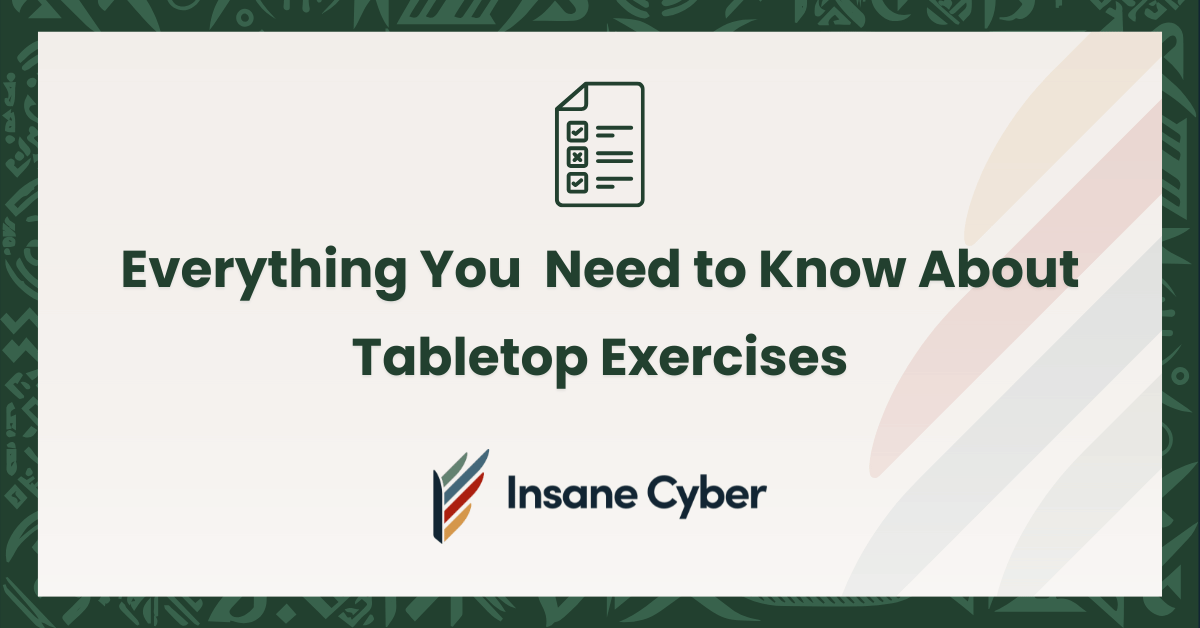What is an OT Tabletop Exercise?
An Operational Technology (OT) Tabletop Exercise (TTX) is a structured, discussion-based simulation that helps organizations assess their readiness to respond to cybersecurity incidents.
These exercises create a low-risk environment for teams to identify gaps in their procedures, improve response strategies, and enhance overall cybersecurity posture.
At Insane Cyber, we tailor each TTX to align with the customer’s operational environment and threat landscape, ensuring maximum relevance and impact.
Types of Tabletop Exercises
Tabletop exercises vary in scale, from small team discussions to organization-wide simulations.
Below are the primary types of OT TTXs, which can be combined into hybrid formats for a comprehensive evaluation.
1. Operational and Technical Exercises
These exercises focus on the frontline teams responsible for detecting and mitigating cybersecurity incidents. The key components include:
- Testing Incident Response Plans (IRP), Emergency Action Plans (EAP), and Continuity of Operations Plans (COOP).
- Assessing the detection, analysis, and response capabilities of IT and OT security teams.
2. Crisis Management Exercises
Designed for broader organizational response, these exercises test business continuity, decision-making, and cross-functional coordination. The main elements include:
- Evaluating Crisis Management Plans (CMP) and IRPs.
- Engaging incident responders, team leads, and plant managers.
- Strengthening interdepartmental communication and leadership in crisis scenarios.
3. Executive-Level Exercises
These high-level simulations involve senior leadership, including C-suite executives and board members. The key focus areas include:
- Strategic decision-making and governance during major cybersecurity events.
- Ensuring compliance with SEC Cybersecurity Risk Management, Strategy, Governance, and Incident Disclosure Rules (2023).
- Aligning legal, compliance, and communication strategies with industrial cybersecurity best practices.
Key Components of a Tabletop Exercise
Each TTX consists of carefully structured phases to maximize its effectiveness:
1. Planning & Preparation
- Conducting kick-off meetings to define objectives, scope, and participants.
- Reviewing relevant documentation (IRP, CMP, COOP, etc.).
- Identifying threats based on the organization’s threat landscape.
2. Scenario Development
- Crafting realistic cyberattack scenarios tailored to the organization’s industry.
- Developing exercise materials, including background details, timeline, and incident injects.
3. Execution & Facilitation
- Running a guided discussion led by expert facilitators.
- Simulating real-world cyber incidents and testing response strategies.
- Encouraging active participation and collaboration among teams.
4. After-Action Analysis & Improvement Plan
- Delivering an After-Action Report (AAR) summarizing findings, team performance, and key takeaways.
- Developing an Improvement Plan (IP) with actionable recommendations for enhancing cybersecurity posture.
Deliverables: What Organizations Gain from a Tabletop Exercise
A well-executed OT TTX provides tangible value, including:
- Enhanced incident response readiness for cybersecurity events.
- Stronger cross-functional collaboration between IT, OT, and leadership teams.
- Compliance assurance with industry regulations and governance frameworks.
- Customized reports (AAR & IP) outlining gaps, recommendations, and next steps.
At Insane Cyber, we have facilitated over 50+ industrial TTXs for organizations ranging from small teams to Fortune 50 enterprises, covering industries such as utilities, manufacturing, and transportation.
10 Expert Tips for Maximizing Your Tabletop Exercise
To get the most out of your TTX, follow these best practices:
1. Reference a Response Plan
Ensure a structured incident response plan (IRP) is in place before running an exercise. Over time, exercises can expand to test multiple processes and procedures.
2. Involve the Right Participants
Include key stakeholders from operations, engineering, and management. A smaller, focused group works best for organizations new to OT cybersecurity.
3. Set the Right Tone
A low-stress, no-fault environment fosters open discussion and idea-sharing to enhance response strategies.
4. Ensure Real-World Relevance
Design scenarios based on likely threats (e.g., ransomware attacks) and their potential impact on operations and business continuity.
5. Promote Active Participation
Incident response is a team effort—facilitators should engage participants through interactive discussions and decision-making exercises.
6. Maintain Realism
Focus on plausible attack scenarios rather than far-fetched cyber threats. Understanding OT process constraints (e.g., mechanical fail-safes) is crucial.
7. Choose the Right Facilitator
A skilled facilitator should provide realistic context, adapt to evolving scenarios, and challenge participants throughout the exercise.
8. Allocate Sufficient Time
For a 10-20 participant exercise with 5-10 scenario injects, schedule at least 2-3 hours for effective engagement.
9. Focus on Process Improvement
Use the exercise to refine response strategies and identify weaknesses before they become real-world vulnerabilities.
10. Build Bridges Between Teams
Encourage cross-departmental collaboration to break silos and strengthen collective cybersecurity resilience.
Conclusion: Elevate Your Cybersecurity Preparedness with TTX
OT tabletop exercises are a powerful tool for organizations seeking to improve their cybersecurity resilience, response efficiency, and regulatory compliance. By engaging the right stakeholders, simulating real-world threats, and continuously refining processes, organizations can stay ahead of evolving cyber risks.
Are you ready to test and strengthen your cybersecurity strategy? Let’s Chat!
Contact Insane Cyber to design a customized OT Tabletop Exercise that meets your organization’s unique needs.






